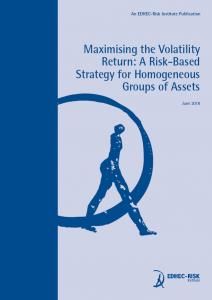

Maximising the Volatility Return: A Risk-Based Strategy for Homogeneous Groups of Assets
The long-term performance of any portfolio can be decomposed as the sum of the weighted average long-term return of its assets plus the volatility return of the portfolio. Hence, maximising the vol ...
Author(s):
Summary:
The long-term performance of any portfolio can be decomposed as the sum of the weighted average long-term return of its assets plus the volatility return of the portfolio. Hence, maximising the volatility return of portfolios of assets with similar characteristics, such as factor portfolios, yields an important increase in performance and risk-adjusted return relative to market-cap weighted factor portfolios. We derive the closed-form solution of the strategy as well as properties that relate it to other risk-based weighting rules, such as minimum variance and risk parity. In our empirical test, partitioning a universe of stocks into homogeneous groups and applying a block-wise maximum volatility return strategy (MVR) yields a more efficient portfolio than standard market-cap and equal-weighted indices.
Register to download PDF
Register/Log in| Type : | EDHEC Publication |
|---|---|
| Date : | 01/06/2018 |

